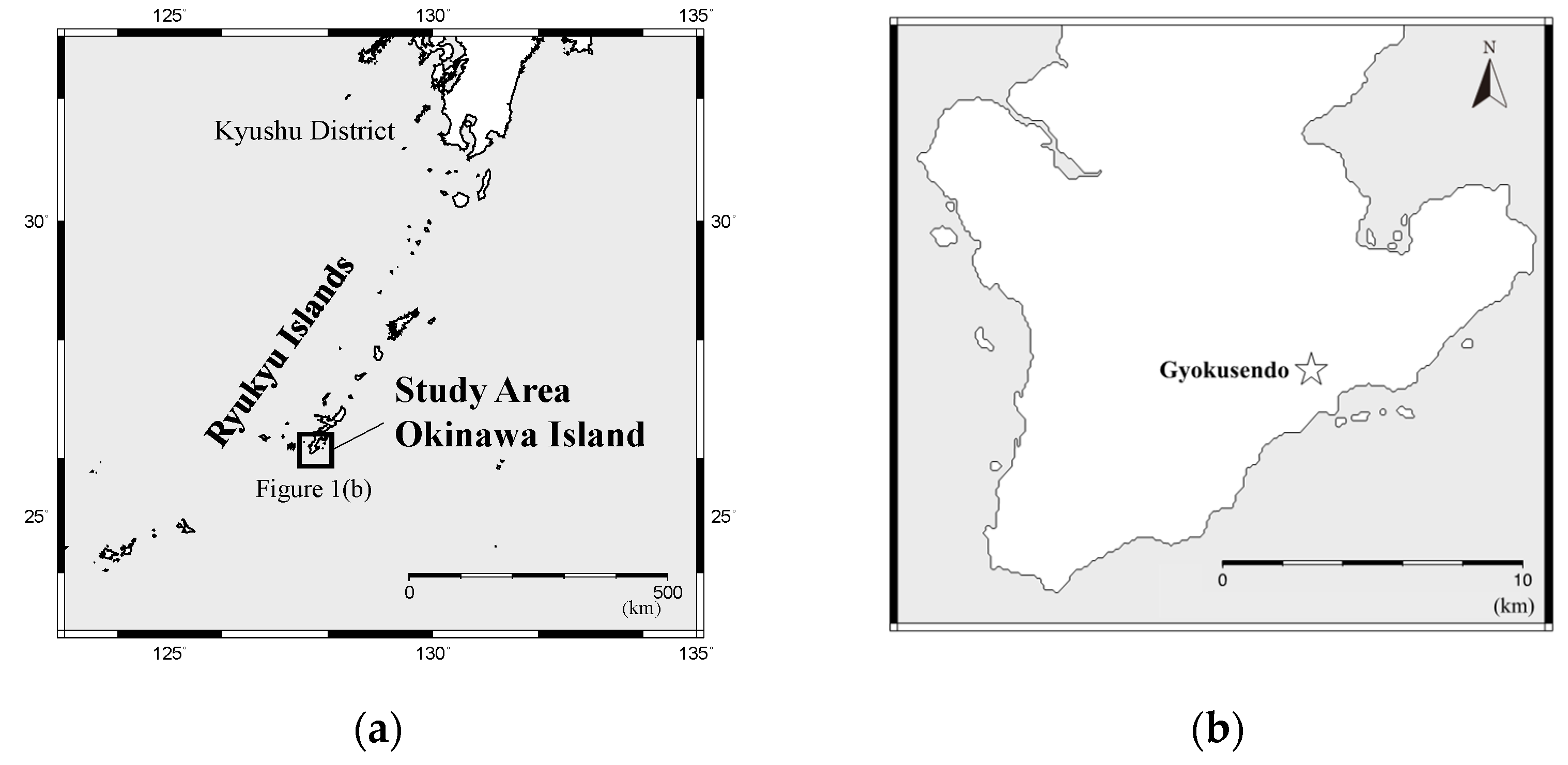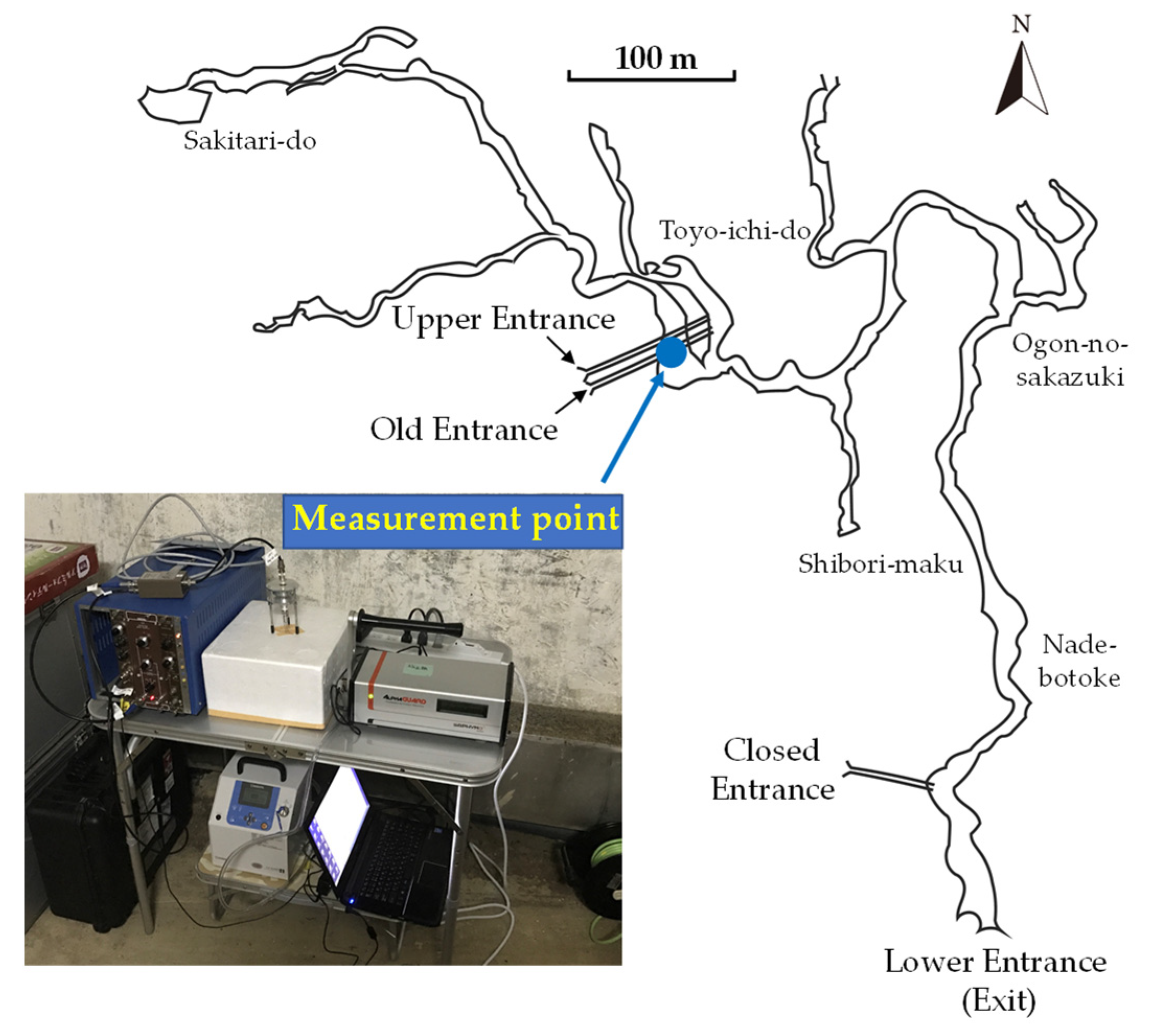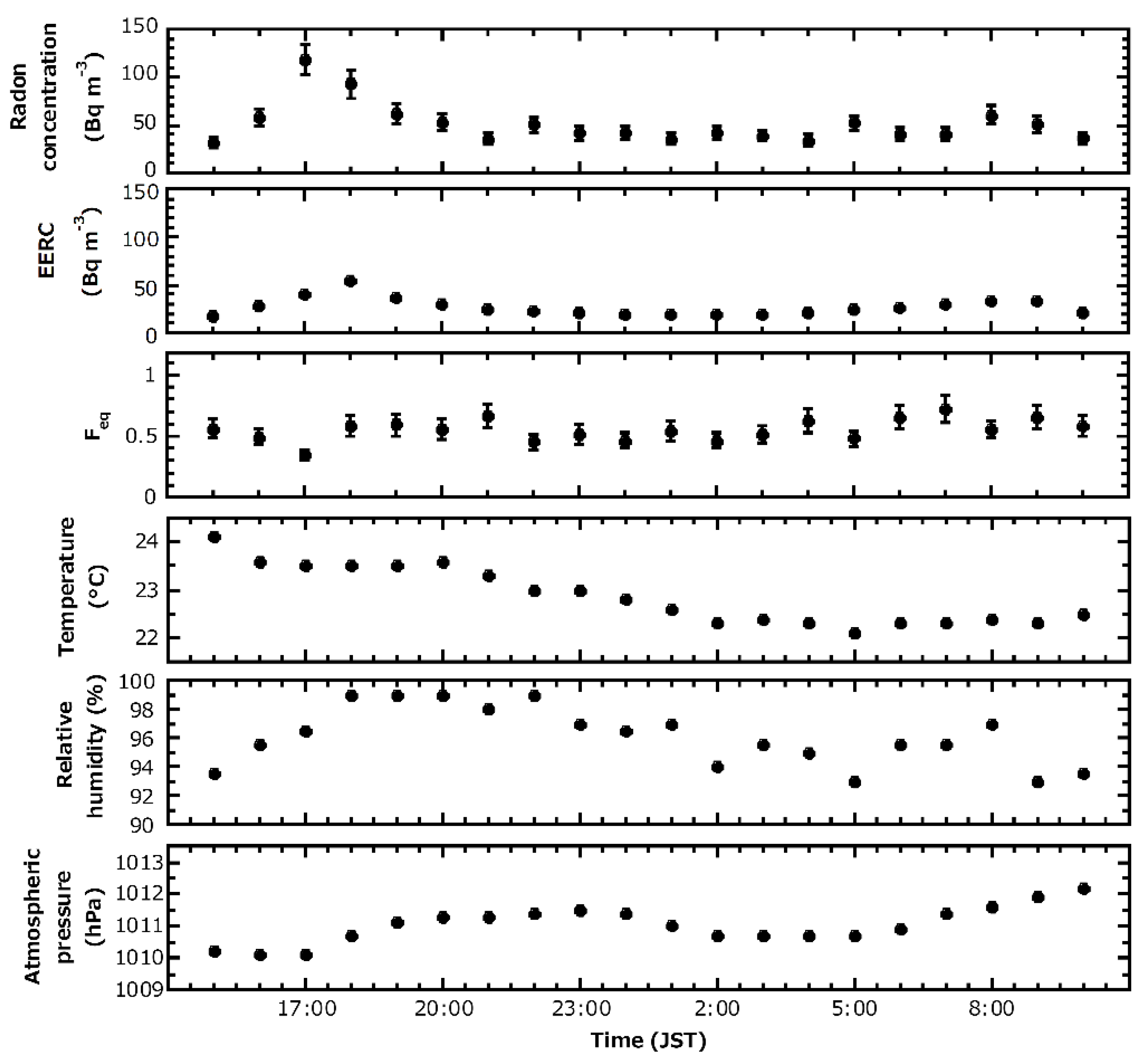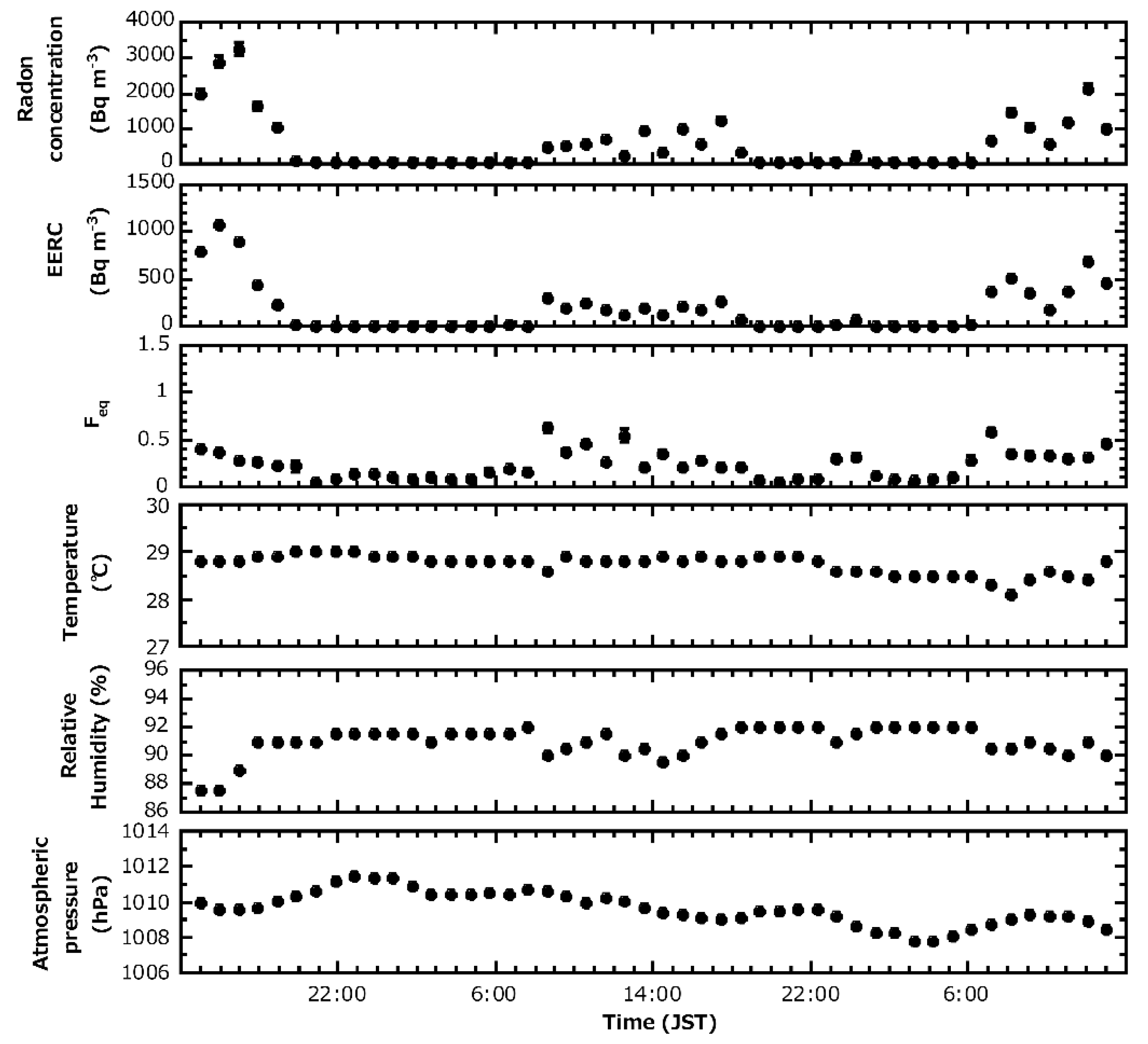A Preliminary Study of Radon Equilibrium Factor at a Tourist Cave in Okinawa, Japan
Abstract
:1. Introduction
2. Materials and Methods
2.1. Measurement Site and Methods
2.2. Evaluation Method of EERC Using the CAM
3. Results
3.1. January 2017 Measurement
3.2. July 2017 Measurement
4. Discussion
5. Conclusions
Author Contributions
Funding
Institutional Review Board Statement
Informed Consent Statement
Data Availability Statement
Acknowledgments
Conflicts of Interest
References
- World Health Organization (WHO). WHO Handbook on Indoor Radon; WHO Press: Geneva, Switzerland, 2009; pp. 1–94. [Google Scholar]
- Wilkening, M.H.; Watkins, D.E. Air exchange and 222Rn concentrations in the Carlsbad Caverns. Health Phys. 1976, 31, 139–145. [Google Scholar] [CrossRef]
- Solomon, S.B.; Cooper, M.B.; O’Brien, R.S.; Wilkinson, L. Radon exposure in a limestone cave. Radiat. Prot. Dosim. 1992, 45, 171–174. [Google Scholar] [CrossRef]
- Lario, J.; Sánchez-Moral, S.; Cuezva, S.; Taborda, M.; Soler, V. High 222Rn levels in a show cave (Castañar de Idor, Spain): Proposal and application of management measures to minimize the effects on guides and visitors. Atmos. Environ. 2006, 40, 7395–7400. [Google Scholar] [CrossRef]
- Amin, R.M.; Eissa, M.F. Radon level and radon effective dose rate determination using SSNTDs in Sannur cave, Eastern desert of Egypt. Environ. Monit. Assess. 2008, 143, 59–65. [Google Scholar] [CrossRef]
- Lu, X.; Li, L.Y.; Zhang, X. An environmental risk assessment of radon in Lantian karst cave of Shaanxi, China. Water Air Soil Pollut. 2009, 198, 307–316. [Google Scholar] [CrossRef]
- Somlai, J.; Hakl, J.; Kávási, N.; Szeiler, G.; Szabó, P.; Kovács, T. Annual average radon concentration in the show caves of Hungary. J. Radioanal. Nucl. Chem. 2011, 287, 427–433. [Google Scholar] [CrossRef]
- García Paz, F.A.; Gonzalez Romero, Y.A.; Zalakeviciute, R. Radon (222Rn) concentrations in the touristic Jumandy cave in the Amazon region of Ecuador. J. Radiat. Res. 2019, 60, 759–767. [Google Scholar] [CrossRef] [Green Version]
- International Commission on Radiological Protection (ICRP). Occupational Intakes of Radionuclides: Part 3. ICRP Publication 137. Ann. ICRP 2017, 46, 1–487. [Google Scholar] [CrossRef] [PubMed]
- Tokonami, S. Some thought on new dose conversion factors for radon progeny inhalation. Jpn. J. Health Phys. 2018, 53, 282–293, (In Japanese with English Abstract). [Google Scholar] [CrossRef] [Green Version]
- United Nation Scientific Committee on the Effects of Atomic Radiation (UNSCEAR). UNSCEAR 2006 Report to the General Assembly, with Scientific Annexes; United Nations: New York, NY, USA, 2009; Volume II. [Google Scholar]
- Sanada, T.; Fujimoto, K.; Miyano, K.; Doi, M.; Tokonami, S.; Uesugi, M.; Takata, Y. Measurement of nationwide indoor Rn concentration in Japan. J. Environ. Radioact. 2019, 45, 129–137. [Google Scholar] [CrossRef]
- Kudo, H.; Tokonami, S.; Omori, Y.; Ishikawa, T.; Iwaoka, K.; Sahoo, S.K.; Akata, N.; Hosoda, M.; Wanabongse, P.; Pornnumpa, C.; et al. Comparative dosimetry for radon and thoron in high background radiation areas in China. Radiat. Prot. Dosim. 2015, 167, 155–159. [Google Scholar] [CrossRef]
- Chen, J.; Harley, N.H. A review of indoor and outdoor radon equilibrium factors—Part I: 222Rn. Health Phys. 2018, 115, 490–499. [Google Scholar] [CrossRef]
- Hosoda, M.; Nugraha, E.D.; Akata, N.; Yamada, R.; Tamakuma, Y.; Sasaki, M.; Kelleher, K.; Yoshinaga, S.; Suzuki, T.; Rattanapongs, C.P.; et al. A unique high natural background radiation area–Dose assessment and perspectives. Sci. Total Environ. 2021, 750, 142346. [Google Scholar] [CrossRef]
- Cigna, A.A. Radon in caves. Int. J. Speleol. 2005, 34, 1–18. [Google Scholar] [CrossRef]
- Chen, J.; Harley, N.H. A Review of Radon Equilibrium Factors in Underground Mines, Caves, and Thermal Spas. Health Phys. 2020, 119, 342–350. [Google Scholar] [CrossRef]
- Jovanovič, P. Radon measurements in karst caves in Slovenia. Environ. Int. 1996, 22, 429–432. [Google Scholar] [CrossRef]
- Vaupotič, J. Nanosize radon short-lived decay products in the air of the Postojna Cave. Sci. Total Environ. 2008, 393, 27–38. [Google Scholar] [CrossRef] [PubMed]
- Tanahara, A.; Taira, H.; Takemura, M. Radon distribution and the ventilation of a limestone cave on Okinawa. Geochem. J. 1997, 31, 49–56. [Google Scholar] [CrossRef]
- Fujimoto, K.; Iimoto, T.; Furukawa, M.; Tokonami, S. Study on the exposure dose from indoor or outdoor radon etc. Survey of radon concentration in residential environment. In Radioactive Environment Study Report (1997); NIRS-R-35; National Institute of Radiological Sciences (Planning Office), Ed.; National Institute of Radiological Sciences: Chiba, Japan, 1998; pp. 28–31. (In Japanese) [Google Scholar]
- Yamada, R.; Tamakuma, Y.; Iwaoka, K.; Hosoda, M.; Shiroma, Y.; Akata, N.; Mizuno, H.; Yamada, K.; Kuroki, T.; Tokonami, S. Measurement system for alpha and beta emitters with continuous air sampling under different exposure situations. Appl. Radiat. Isot. 2017, 126, 79–82. [Google Scholar] [CrossRef]
- Ooka, S.; Sasaki, H.; Ishihara, Y.; Yoshimura, K. Cave air ventilation associated with speleothem formation in the Gyokusen-do Cave, Nanjo City, Okinawa Island, Southwest Japan. J. Speleol. Soc. Jpn. 2018, 43, 17–36, (In Japanese with English Abstract). [Google Scholar]
- Shiroma, Y.; Shiroma, M.; Kina, S.; Hosoda, M.; Yasuoka, Y.; Akata, N.; Furukawa, M. Source of atmospheric radon in the Gyokusendo, a limestone cave in Okinawa. Jpn. J. Health Phys. 2016, 51, 218–226, (In Japanese with English Abstract). [Google Scholar] [CrossRef] [Green Version]
- Nakasone, S.; Ishimine, A.; Shiroma, S.; Masuda, N.; Nakamura, K.; Shiroma, Y.; Ooka, S.; Tanaka, M.; Kato, A.; Hosoda, M.; et al. Temporal and Spatial Variation of Radon Concentrations in Environmental Water from Okinawa Island, Southwestern Part of Japan. Int. J. Environ. Res. Public Health 2021, 18, 998. [Google Scholar] [CrossRef] [PubMed]
- The International Commission on Radiation Units and Measurements (ICRU). ICRU Report 88, Measurement and reporting of radon exposures. J. ICRU 2012, 12, 1–191. [Google Scholar]
- Tokonami, S.; Ichiji, T.; Iimoto, T.; Kurosawa, R. Calculation procedure of potential alpha energy concentration with continuous air sampling. Health Phys. 1996, 71, 937–943. [Google Scholar] [CrossRef]
- Pornnumpa, C.; Oyama, Y.; Iwaoka, K.; Hosoda, M.; Tokonami, S. Development of radon and thoron exposure systems at Hirosaki University. Radiat. Environ. Med. 2018, 7, 13–20. [Google Scholar]
- Tamakuma, Y.; Yamada, R.; Hosoda, M.; Iwaoka, K.; Tokonami, S. Evaluation of a surface collection efficiency and a stability of flow rate for the commercially available filters used for ambient radioactive aerosols. Jpn. J. Heath Phys. 2019, 54, 5–12, (In Japanese with English Abstract). [Google Scholar] [CrossRef]
- Przylibski, T.A. Radon concentration changes in the air of two caves in Poland. J. Environ. Radioact. 1999, 45, 81–94. [Google Scholar] [CrossRef]
- Kowalczk, A.J.; Froelich, P.N. Cave air ventilation and CO2 outgassing by radon-222 modeling: How fast do caves breathe? Earth Planet. Sci. Lett. 2010, 289, 209–219. [Google Scholar] [CrossRef]
- Gregorič, A.; Zidanšek, A.; Vaupotič, J. Dependence of radon levels in Postojna Cave on outside air temperature. Nat. Hazards Earth Syst. Sci. 2011, 11, 1523–1528. [Google Scholar] [CrossRef] [Green Version]
- Nagy, H.É.; Szabó, Z.; Jordán, G.; Szabó, C.; Horváth, Á.; Kiss, A. Time variations of 222Rn concentration and air exchange rates in a Hungarian cave. Isot. Environ. Health Stud. 2012, 48, 464–472. [Google Scholar] [CrossRef] [PubMed]
- Tanahara, A.; Iha, H.; Taira, H. Factors controlling the changes in 222Rn concentration in Gyokusen Cave on Okinawa Island. J. Speleol. Soc. Jpn. 1997, 22, 98–105, (In Japanese with English Abstract). [Google Scholar]
- Szerbin, P. Radon concentrations and exposure levels in Hungarian caves. Health Phys. 1996, 71, 362–369. [Google Scholar] [CrossRef] [PubMed]
- Duffy, J.T.; Madden, J.S.; Mackin, G.M.; McGarry, A.T.; Colgan, P.A. A reconnaissance survey of radon in show caves in Ireland. Environ. Int. 1996, 22, 415–423. [Google Scholar] [CrossRef]
- Sas, D.; Navrátil, O.; Sládek, P. Monitoring of natural factors in Czech speleotherapeutic centres. Czechoslov. J. Phys. 1999, 49, 103–106. [Google Scholar] [CrossRef]
- Zahorowski, W.; Whittlestone, S.; James, J.M. Continuous measurements of radon and radon progeny as a basis for management of radon as a hazard in a tourist cave. J. Radioanal. Nucl. Chem. 1998, 236, 219–225. [Google Scholar] [CrossRef]
- Kávási, N.; Somlai, J.; Kovács, T.; Szabó, T.; Várhegyi, A.; Hakl, J. Occupational and patient doses in the therapeutic cave, Tapolca (Hungary). Radiat. Prot. Dosim. 2003, 106, 263–266. [Google Scholar] [CrossRef] [PubMed]
- Tokonami, S.; Iimoto, T.; Kurosawa, R. Continuous measurement of the equilibrium factor F and the unattached fraction fp of radon progeny in the environment. Environ. Int. 1996, 22, 611–616. [Google Scholar] [CrossRef]
- Chen, C.J.; Liu, C.C.; Lin, Y.M. Measurement of equilibrium factor and unattached fraction of radon progeny in Kaohsiung, Taiwan. Appl. Radiat. Isot. 1998, 49, 1613–1618. [Google Scholar] [CrossRef]
- Paul, A.; Röttger, S.; Honig, A.; Sulima, T.; Buchholz, A.; Keyser, U. Measurement of short-lived radon progenies by simultaneous αγ-spectrometry at the German radon reference chamber. Nucl. Instrum. Methods Phys. Res. A 1999, 434, 303–312. [Google Scholar] [CrossRef]






Publisher’s Note: MDPI stays neutral with regard to jurisdictional claims in published maps and institutional affiliations. |
© 2021 by the authors. Licensee MDPI, Basel, Switzerland. This article is an open access article distributed under the terms and conditions of the Creative Commons Attribution (CC BY) license (https://creativecommons.org/licenses/by/4.0/).
Share and Cite
Yamada, R.; Tamakuma, Y.; Suzuki, T.; Nakasone, S.; Shiroma, Y.; Furukawa, M.; Hashimoto, H.; Hosoda, M.; Akata, N.; Tokonami, S. A Preliminary Study of Radon Equilibrium Factor at a Tourist Cave in Okinawa, Japan. Atmosphere 2021, 12, 1648. https://doi.org/10.3390/atmos12121648
Yamada R, Tamakuma Y, Suzuki T, Nakasone S, Shiroma Y, Furukawa M, Hashimoto H, Hosoda M, Akata N, Tokonami S. A Preliminary Study of Radon Equilibrium Factor at a Tourist Cave in Okinawa, Japan. Atmosphere. 2021; 12(12):1648. https://doi.org/10.3390/atmos12121648
Chicago/Turabian StyleYamada, Ryohei, Yuki Tamakuma, Takahito Suzuki, Shunya Nakasone, Yoshitaka Shiroma, Masahide Furukawa, Hiroki Hashimoto, Masahiro Hosoda, Naofumi Akata, and Shinji Tokonami. 2021. "A Preliminary Study of Radon Equilibrium Factor at a Tourist Cave in Okinawa, Japan" Atmosphere 12, no. 12: 1648. https://doi.org/10.3390/atmos12121648
APA StyleYamada, R., Tamakuma, Y., Suzuki, T., Nakasone, S., Shiroma, Y., Furukawa, M., Hashimoto, H., Hosoda, M., Akata, N., & Tokonami, S. (2021). A Preliminary Study of Radon Equilibrium Factor at a Tourist Cave in Okinawa, Japan. Atmosphere, 12(12), 1648. https://doi.org/10.3390/atmos12121648







